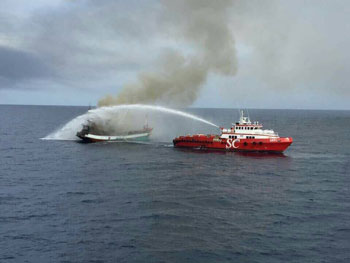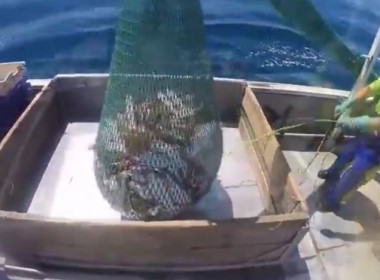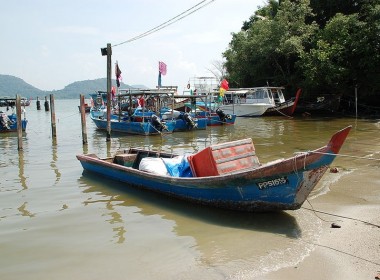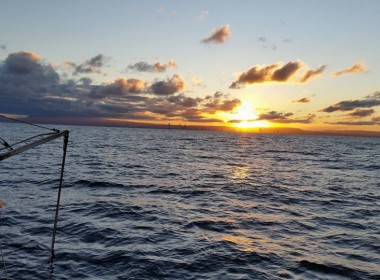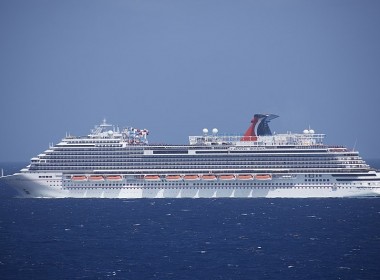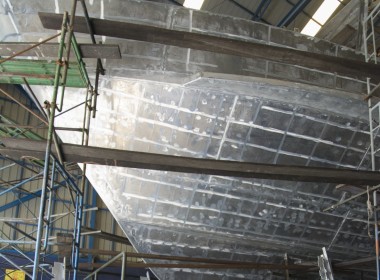FEATURE: Mariola – Designed and built by fishermen for fishermen
Tom Aliotti’s new Bristol Bay gillnetter Mariola did 36 knots on sea trials. Asked the secret of getting that speed, he replied, “I’m not going to tell you my secret, except that I have fished Bristol Bay for 33 years and I use that knowledge to build boats for fishermen.”
Staying within the legally proscribed 32-foot (9.8-metre) limit for Bristol Bay gillnet boats creates a challenge that eager designers like Aliotti are happy to take on. “But it is not all about light boat speed,” he explained, “It matters to me what speed you can maintain with the weight of fish onboard and how a boat performs in weather. There are compromises to be made and I can design and build to those.”
From that description, the discussion gets interesting, as a client coming to Aliotti Enterprises for a new boat can tell Tom just what compromises he is interested in making and Tom can design to that desired balance. In the past few days, there have been two, near sister ships, launched into Bellingham Bay in anticipation of the June opening on Bristol Bay that will last for only six weeks.
Allioit’s hulls have a wide lift chine, but even there, he balances it to allow for a finer entrance at the bow. This is so that the boat won’t pound when driving up against a nasty chop that summer winds can bring to the Bay. Aliotti built three boats this past winter. The same Cummins QSC8.3-liter engines, producing 367kW each at 2650rpm, power two of the three. These two boats have identical 4.7-metre wide hulls. But the drives, aft of the engines, have some differences.
Both boats have ZF gears and Ultrajet water-jet drives. Indy Walton’s boat, Sniper, has Ultrajet 340 drives turned by ZF305 gears, and Aliotti’s boat, the Mariola, has Ultrajet 340hd drives turned by ZF286 gears. “My drives are 1.5-inches bigger in circumference than Indy’s drives,” Aliotti said. The difference in performance, he explained, is pronounced. With 1,500 litres of fuel onboard, both boats weigh about 12.7 tonnes. On sea trials Walton’s Sniper will likely clock 40 or more knots; in virtually identical trials, Aliotti’s Mariola with the bigger jets did 36 knots.
Light boat sea trial speeds are important, but these are fishing boats and are designed to perform, ready to fish, at 12.5 to 13.5 tonnes net weight. In addition, they can pack up to 13 tonnes of sockeye salmon in their 13 individual RSW holds. The two boats will fish different regions of Bristol Bay, Walton in Naknek and Aliotti in Egegik, but the two regions put similar demands on the boats with a mix of distance, tide and wind. The most important factor is personal preference as to where speed matters. Aliotti feels a greater need for loaded speed.
Meanwhile, Walton, opting for a greater light boat speed, expects that he will still get up on the step and make good speed with 4.5 or even 5.5 tonnes onboard. Building a boat that costs well north of a half million dollars is done by fishermen with very particular expectations. “My boat interior is nicely finished and comfortable for a crew of five,” explained Aliotti, “But if you want to see a really classy finish, take a look at the interior of Indy’s boat.”
Walton chose Aliotti to design and build his boat because of the strong framings system, with the frames only 70cm apart with multiple stiffeners running fore and aft. With the engines, gears, jets and exhaust all set in place, Walton moved the Sniper over to Bellingham’s Colony Wharf Coop where a team of gifted trades people did the detailed finishing The result is a spectacular boat from the carbon fibre dash cover in the wheelhouse to the carbon fiber lettering for the name and home port on the stern. An innovative design allows for a comfortable skipper’s berth in the wheelhouse and a exceptionally clean finish to the walls with one-inch of insulation in the accommodation area with fridge, stove and private head. This, together with cargo holds and engine room is all fitted into a 9.8-metre hull.
On deck, both boats have Kennimatics anchor winches and net drums. Asked about the apparently narrow (0.5- by 1.5-metre) net drum, Walton says, “That allows me to set my net at 25 knots without getting a back lash.”
Walton will fish with a crew of five including his 22-year-old daughter Bristol and 13-year-old son Dylan. “We bleed and float all of our fish in RSW to get about 25 cents additional per pound,” he explained, “The large crew allows us to do this even in heavy fishing.”
This summer Walton’s mom, wife, and another daughter will continue the family set-net operations while his son Dagen will take over his other boat, Double Dippin’. And so, in one of the world’s most valuable, most intense and briefest fisheries, these two boats will join what is undoubtedly the world’s most high-tech, small boat fleet.


